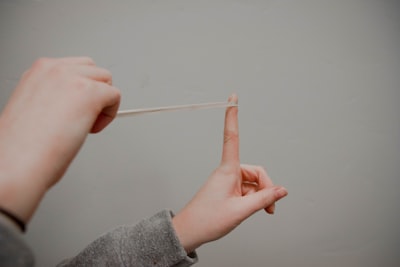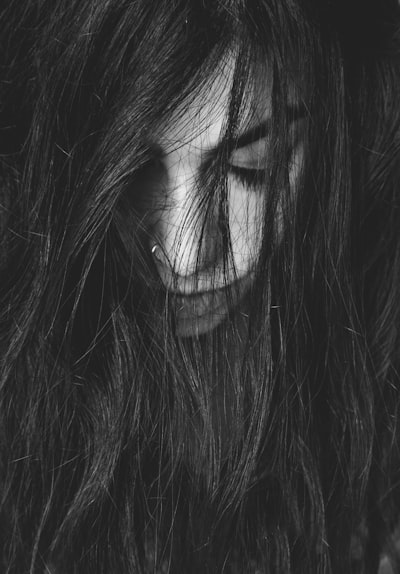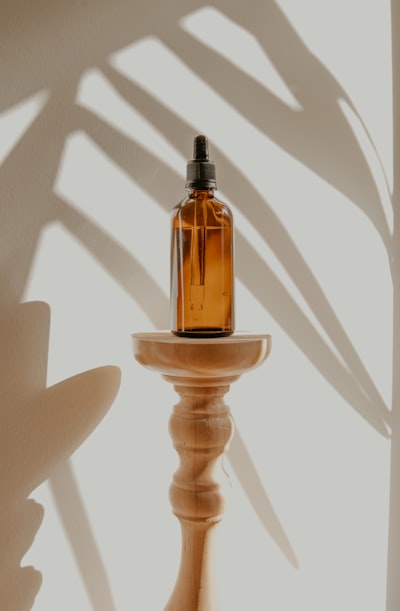Fixing Bad Hair Extension Mishaps Brazilian Knot Damage
Bad hair extension mishaps can be a nightmare, leaving you with tangles, breakage, and overall hair damage. We've all heard horror stories of extensions gone wrong, and it's important to understand how to fix these issues if you find yourself in a hair extension disaster. In this blog, we will explore common challenges with hair extensions and provide effective techniques for extension removal, damage control for hair post-extension removal, alternatives to problematic extension methods, and tips for preventing future hair extension mishaps. Whether you're dealing with excessive weight, breakage, or challenges in removing hair extensions, we've got you covered with expert advice and real-life tips that will help you achieve the hair of your dreams without the headache. So, let's dig in and learn how to fix bad hair extension mishaps once and for all.
Recently, a lovely client came to our salon with heavy hair wefts, supported with several large sections of Brazilian Knots (see picture), they were too heavy for her hair which caused her hair to break. Additionally, the elasticized knots were attached to very large sections of her hair which pulled excessively on her scalp. It took 3 hours to carefully remove her extensions, we then treated her hair with a steam scalp and hair conditioner, she was anxious to reinstall her hair extensions, but we asked her to wait for 1 week to evaluate her hair condition. Once her scalp returned to normal, we carefully applied her hair extensions in beaded rows in areas that were not previously attached. We selected areas of her hair that were healthy and did a gentle sew-in technique. She was elated to take the pressure off of her head and found our method to be far more successful. Additionally, we were able to reuse her expensive hair from Brazil.
A Picture Says A Thousand Words - Her Hair
Excessive shedding due to too much weight
The Brazilian Knot Elastic is too tight and does not have enough support to hold wefts
Shedding, Matting, and Tension
Significance of Quality in Hair Extensions
When it comes to hair extensions, good quality is of utmost importance. Whether you opt for human hair extensions or synthetic hair extensions, investing in good-quality extensions ensures natural-looking results and durability. High-quality extensions, whether they are made from human hair or synthetic fibers, are less likely to cause tangles and breakage. Good quality extensions also tend to be easier to style and maintain, allowing you to achieve various looks effortlessly. Human hair extensions, especially those of good quality, can be styled using hot tools and specific hair products, just like your own hair. On the other hand, synthetic hair extensions, while more affordable, may have limitations in terms of styling and longevity. However, they often come in pre-styled options, which can be ideal for specific hair needs. It's important to note that human hair extensions require specific hair care products, similar to natural hair, to maintain their quality.
Precision Installation

Common Issues with Hair Extensions
While hair extensions can be a great way to enhance your natural beauty, they are not without their challenges. Understanding these common issues will help you identify and address hair extension mishaps more effectively. Some of the most common issues with hair extensions include the excessive weight of the extensions, breakage due to the elastic of Brazilian Knot extensions, and challenges in removing hair extensions. Let's explore each of these issues and discuss effective techniques for fixing them. In essence, taking the time to remove hair extensions is a key factor in avoiding damage to hair follicles.
Excessive Weight of Hair Extensions
One of the most common challenges with hair extensions is dealing with their excessive weight. When extensions are too heavy, they can put strain on your natural hair, leading to hairline damage, breakage, and scalp discomfort. This is especially true for full-head extensions or extensions that are not properly balanced with your hair. Brazilian Knot extensions, in particular, can be notorious for their weight, and if installed incorrectly, they can cause hair breakage and even tension headaches. If you find yourself struggling with the excessive weight of your hair extensions, it's important to take action to prevent further damage.
Breakage due to Elastic of Brazilian Knot Extensions
Brazilian Knot extensions can be a fantastic way to add length and volume to your hair, but if not installed properly, they can lead to breakage and hairline damage. One of the main culprits of breakage is the elastic used in Brazilian Knot extensions. If the elastic is too tight, it can cause breakage and put strain on your hairline and natural hair. This can result in brittle hair, tangles, and discomfort. To avoid this nightmare, it's crucial to ensure that the elastic used in Brazilian Knot extensions is properly applied to prevent breakage and hairline tension. Taking the time to find a skilled stylist who specializes in Brazilian Knot extensions and understands the importance of proper elastic tension is key to avoiding breakage and hairline damage.
Challenges in Removing Hair Extensions
Removing hair extensions can be a challenging process, especially if you're dealing with tangles, knots, and adhesive residue. One of the biggest challenges in removing hair extensions is ensuring that your natural hair remains undamaged throughout the process. Improper removal techniques can lead to breakage, hair tangles, and scalp discomfort. It's important to approach hair extension removal with caution and use specific hair products and tools that are designed to safely remove extensions without causing damage to your natural hair.

Effective Techniques for Extension Removal Tangles
Now that we've discussed some of the common issues with hair extensions, let's explore effective techniques for extension removal. Safely removing extensions is crucial to prevent breakage, tangles, and other hair mishaps. In this section, we will discuss how to safely remove Brazilian Knot extensions and provide tips for reusing hair wefts post-removal.
Happy
Safely Removing Brazilian Knot Extensions
Removing Brazilian Knot extensions requires a gentle approach to avoid breakage, tangles, and damage to your natural hair. Here are some tips for safely removing Brazilian Knot extensions:
- Detangle and condition first: Before removing Brazilian Knot extensions, it's important to detangle and condition your hair extensions to prevent tangles and breakage.
- Use oil for safe removal: Apply olive oil or natural oil treatment to the knots of the extensions, which will help loosen them and make removal easier.
- Gently comb out the knots: Use a tail comb with wide teeth to gently comb out the knots, starting from the bottom and working your way up to the roots of your hair.
- Consider warm water: Soaking the extensions in warm water can also help to loosen the knots and make them easier to remove.
- Seek professional help if needed: If you're struggling to remove your Brazilian Knot extensions safely, it's best to seek the help of a professional stylist who is experienced in extension removal techniques.

Reusing Hair Wefts Post-Removal
Once you have successfully removed your hair extensions, you may be wondering if there's any way to reuse the hair wefts. The good news is, that with proper cleaning, detangling, and storage, you can reuse hair wefts and get more mileage out of your extensions. Here are some tips for reusing hair wefts post-removal:
- Thoroughly clean the hair wefts: Wash the hair wefts with a gentle shampoo, making sure to remove any excess product or residue.
- Detangle the hair wefts: Use a good quality detangling comb and start from the ends, slowly working your way up to remove any tangles or knots.

Damage Control for Hair Post-Extension Removal
Once the hair extensions have been removed, it's important to address any damage that may have occurred and restore health to your natural hair. In this section, we will discuss how to deal with hair breakage and restore moisture to dry hair.
Dealing with Hair Breakage
Hair breakage is a common issue that many people face after removing hair extensions. The weight of the extensions, along with the tension and stress they put on your natural hair, can weaken it and lead to breakage. To deal with hair breakage, consider the following tips:
- Treat hair with hot oil: Apply a hot oil treatment to your hair to add moisture and improve hair elasticity, which can help reduce breakage.
- Massage scalp with argan oil: Regular scalp massages with argan oil can stimulate hair growth and improve hair health, reducing breakage.
- Opt for sulfate-free shampoo: Use a sulfate-free shampoo to prevent dryness and breakage, as sulfates can strip the hair of its natural oils, causing it to become dry and brittle.
- Trim hair to remove damaged ends: If your hair has suffered significant breakage, it may be necessary to trim the damaged ends to encourage healthy growth and prevent further breakage.
- Implement hair-strengthening treatments: Incorporate hair-strengthening treatments into your hair care routine to help fortify and protect your hair from breakage.
Restoring Health to Damaged Hair - Get a Haircut
Restoring health to damaged hair is essential after removing hair extensions. You can revive your hair and promote its recovery by following these tips:
- Deep condition: Use deep conditioning treatments with steam to nourish and moisturize your hair, helping to restore moisture and repair damage caused by the extensions.
- Incorporate coconut oil: Coconut oil is a great natural conditioner for dry hair extensions. Apply it to your hair, focusing on the ends, to restore moisture and add shine.
- Minimize tangles: Brush your hair extensions with a detangler brush to minimize tangles and prevent breakage. Start from the ends and work your way up to avoid unnecessary pulling and tugging.
- Use olive oil as a natural hair conditioner: Olive oil is a natural and effective hair conditioner. Apply it to your hair, leave it on for a few minutes, and then rinse thoroughly to nourish and hydrate dry hair.
- Visit a professional stylist for hair extension maintenance: Seeking professional guidance for hair extension maintenance is crucial, especially if you have recently removed damaged extensions. A stylist can provide valuable advice on how to restore and maintain the health of your hair.
Alternatives to Problematic Extension Methods
If you're hesitant to go through the hassle of dealing with hair extension mishaps, there are alternative methods that can offer a gentler approach and minimize potential issues. In this section, we will explore the beaded sew-in technique and other gentle hair extension methods that can help you achieve your desired look without sacrificing the health of your natural hair.
The Beaded Sew-In Technique
The beaded sew-in technique is a popular alternative to traditional hair extensions, as it adds minimal stress to your natural hair while still providing length and volume. Here are some key points to consider when opting for the beaded sew-in technique:
- Less tension: Unlike other extension methods that rely on glue or heat, the beaded sew-in technique uses small beads that are attached to your natural hair, creating a secure and comfortable fit without putting excessive tension on your hair.
- Consider hair type and scalp condition: It's important to consult with a stylist who specializes in the beaded sew-in technique to determine if it is suitable for your specific hair type and scalp condition.
- Choose the right type of hair: Selecting the right type of hair extensions, such as human hair wefts, is crucial for achieving a natural look and minimizing damage to your natural hair.
- Pay attention to scalp health: Prioritizing scalp health is essential when opting for the beaded sew-in technique, as it involves the placement of beads close to the scalp. Regular scalp massages and proper cleansing can help maintain a healthy scalp.
Other Gentle Hair Extension Techniques
Aside from the beaded sew-in technique, other hair extension methods offer a gentler approach and can help minimize hair extension mishaps. Here are some examples:
- Tape-in extensions: Tape-in extensions are lightweight and provide a natural look, as they are applied using adhesive tape, which reduces the amount of heat and tension on your natural hair.
- Cold fusion extensions: The cold fusion extension method involves using a keratin-based adhesive to attach the extensions, minimizing the use of heat and reducing the risk of hair damage.
- Glue-less weft extensions: Glue-less weft extensions are applied without the use of glue, preserving the health of your hair and minimizing the risk of breakage and damage.
- Consider specific hair needs: When choosing a hair extension method, it's important to consider your specific hair needs, such as baby hairs or specific styling requirements, to ensure that the method is suitable for you.
- Consult a professional stylist: To determine the best extension method for your specific hair type and needs, it's recommended to consult with a professional stylist who can provide personalized advice and guidance.
Caring for Hair Post Extension Application
Proper care of your hair extensions is essential to maintain their quality, longevity, and overall appearance. In this section, we will discuss the regular maintenance of extensions as well as the proper usage of hair products to ensure that your hair extensions stay healthy and beautiful.
Regular Maintenance of Extensions
Caring for hair extensions requires regular maintenance to keep them looking their best. Here are some tips for maintaining your extensions:
- Use an extension brush: Invest in a good quality brush specifically designed for extensions to prevent breakage of your real hair.
- Avoid wet extensions: When possible, avoid getting your extensions wet, as excessive moisture can cause tangles and frizz. If your extensions do get wet, dry them thoroughly to avoid any potential damage.
- Utilize dry shampoo: Dry shampoo can be a lifesaver when it comes to prolonging the time between washes and keeping your extensions looking fresh.
- Wash extensions with warm water: When it's time to wash your extensions, use warm water instead of hot water, as hot water can strip the extensions of their natural oils, leading to dryness and frizz.
- Schedule regular salon visits: Regular salon visits for maintenance, including shampooing, conditioning, and styling, are essential to keep your extensions in top shape.
Proper Usage of Hair Products
Proper usage of hair products is crucial for maintaining the quality and health of your hair extensions. Here are some tips to keep in mind:
- Incorporate argan oil: Argan oil is a great natural oil that can be used to add moisture and shine to your extensions. Incorporate it into your hair care routine to keep your extensions looking healthy.
- Opt for sulfate-free shampoo: Sulfate-free shampoo is a great option for extensions, as it is gentle and helps maintain the quality of both human hair and synthetic hair extensions.
- Choose hair products with moisture in mind: Extensions, especially human hair extensions, require moisture to stay soft and hydrated. Look for hair products specifically formulated for extensions that provide moisture and hydration.
- Protect extensions from heat: Before using hot tools, apply a heat protectant spray to your extensions to protect against heat damage and keep them looking their best.
- Moisturize extensions with a hair mask: Treat your extensions to a nourishing hair mask once a week to keep them moisturized, soft, and easy to style.

Prevention of Future Hair Extension Mishaps
Preventing future hair extension mishaps is the key to ensuring a positive and enjoyable hair extension experience. In this section, we will discuss the importance of choosing the right extension method and the significance of professional installation and removal.
Choosing the Right Extension Method with your stylist
Choosing the right extension method is essential for achieving natural-looking and long-lasting results. Consider the following factors when selecting an extension method:
- Understanding specific hair needs: Take into account your specific hair type, length, and desired look when choosing an extension method. Different methods may be better suited to certain hair types, so it's important to do your research and consult with a professional stylist.
- Consider salon expertise: If you are unsure which extension method is best for you, it's always a good idea to seek advice from a salon that specializes in hair extensions. They can recommend the most suitable method based on your specific hair needs and preferences.
- Trust the expertise of a stylist: A professional stylist can guide you through the process of selecting the right extension method, ensuring
- that it is installed properly and seamlessly blends with your natural hair.
Importance of Professional Installation and Removal
Professional installation and removal of hair extensions play a crucial role in maintaining the health of your natural hair and preventing potential mishaps. Here's why it's important to entrust the installation and removal of hair extensions to professionals:
- Ensuring damage-free installation: Professional installation ensures that extensions are applied without causing damage to your natural hair. The expertise of a stylist is essential in achieving a seamless and natural look.
- Proper removal techniques: Improper hair extension removal can lead to tangles, breakage, and other hair mishaps. A stylist knows how to remove extensions safely, minimizing the risk of damage to your natural hair.
- Blending extensions seamlessly: Stylists have the experience and expertise to blend extensions seamlessly with your natural hair, ensuring a natural and undetectable look.
- Access to professional tools and hot tools: Professional stylists have access to specialized tools, such as extension-specific brushes and hot tools, that are designed to protect your extensions and natural hair during styling.
- Guidance on extension care and maintenance: Professional stylists can provide valuable advice on how to care for your extensions, including proper brushing techniques, maintenance routines, and the use of specific hair products.
Conclusion
In conclusion, it's crucial to understand the significance of high-quality hair extensions and the potential challenges that can arise during their application and removal. By opting for professional installation and removal, you can minimize the risks of excessive weight, breakage, and other mishaps. Additionally, considering alternative extension methods such as the beaded sew-in technique can offer a gentler and more secure option for long-lasting results. Proper care and maintenance of your extensions, including regular maintenance appointments and the use of suitable hair products, will help preserve their appearance and health. Lastly, it's essential to choose the right extension method based on your hair type and consult with a professional to ensure a positive experience. If you're seeking further guidance or assistance, book a free consultation with our experts for personalized advice. Free consultations.















